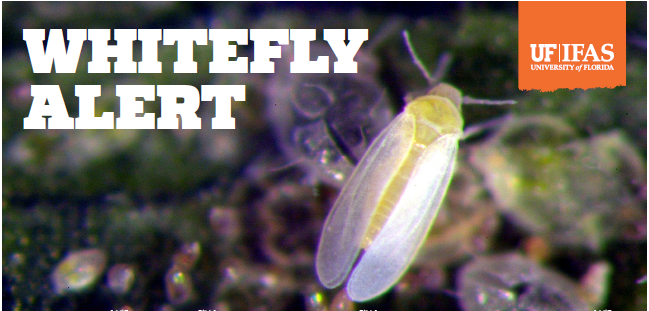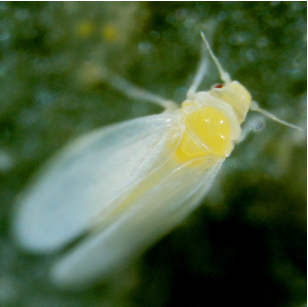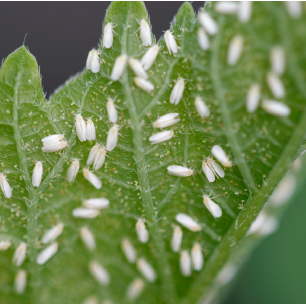 Brad Buck, UF/IFAS Communications
Brad Buck, UF/IFAS Communications
Situation
 The Q-biotype whitefly, a significant tropical and subtropical pest, may threaten Florida crops such as tomatoes, squash, beans, watermelons and many other vegetables and ornamentals if immediate measures are not taken to prevent its spread.
The Q-biotype whitefly, a significant tropical and subtropical pest, may threaten Florida crops such as tomatoes, squash, beans, watermelons and many other vegetables and ornamentals if immediate measures are not taken to prevent its spread.
Scientists statewide, including those with the University of Florida Institute of Food and Agricultural Sciences (UF/IFAS), are working together to control the whitefly which, for the first time, has been found outside greenhouses and nurseries in Florida. Known scientifically as Bemisia tabaci, the Q-biotype or Mediterranean whitefly is a light-colored, flying insect slightly less than 1 millimeter in length.
Researchers with UF/IFAS are working with the U.S. Department of Agriculture, Agricultural Research Service and the Florida Department of Agriculture and Consumer Services to manage the whitefly.
“Unfortunately, we have a developing whitefly issue in Florida,” said Lance Osborne, a faculty member at the UF/IFAS Mid-Florida Research and Education Center in Apopka, Florida. “The situation may be improved with diligent attention to identifying and reporting any outbreaks.”
This marks the first time the Q-biotype of Bemisia tabaci has been found outside a greenhouse or nursery in the United States since it was found on an ornamental plant in a greenhouse in 2004-2005, said Osborne, a UF/IFAS entomology professor.
What can be done?
The following measures are recommended to control the spread of Q-biotype whitefly:
- Homeowners who suspect they have a whitefly infestation should contact their UF/IFAS Extension county office. Office locations may be found at http://bit.ly/1Q8wguw.
- For identification purposes, infested leaves and dead insect specimens should be brought to local Extension offices. Wrap in a dry paper towel and place in a seal-able plastic bag and then in an envelope. Freezing the specimen overnight before transport is highly recommended. Live insects should not be transported.
- The collection information should be included with the sample. Date, location, what type of vegetation is affected, number of suspected whiteflies, and any information about whether a pesticide has been used on the plant, is helpful information to managing the pest. For steps on how to submit a sample to FDACS DPI, visit http://www.freshfromflorida.com/Divisions-Offices/Plant-Industry/Business-Services/Submit-a-Sample-for-Identification.
- Because new populations have built up resistance to chemicals, it is recommended that suspected whitefly infestations be confirmed before chemically treating the insects, as it may be needless to spray pesticides.
- Landscapers and pest control operators should inspect for signs of whitefly pests, communicate with neighboring properties and homeowners associations, employ good management and growing practices, and implement whitefly management guidelines available at http://mrec.ifas.ufl.edu/lso/bemisia-WhiteflyManagementProgram_2014.pdf.
- Nurseries that suspect whitefly infestations should contact the FDACS Division of Plant Industry at 1-888-397-1517.
Background
 There are two whitefly biotypes, referred to as Bemisia tabaci. The Q-biotype has been detected in a number of landscapes in Palm Beach County—Boca Raton, Boynton Beach, Palm Beach and Palm Beach Gardens. Samples from all the other difficult-to-manage populations are the B-biotype. Currently, only the Q-biotype has been found in these four areas.
There are two whitefly biotypes, referred to as Bemisia tabaci. The Q-biotype has been detected in a number of landscapes in Palm Beach County—Boca Raton, Boynton Beach, Palm Beach and Palm Beach Gardens. Samples from all the other difficult-to-manage populations are the B-biotype. Currently, only the Q-biotype has been found in these four areas.
Scientists consider Bemisia tabaci a major invasive species worldwide. It feeds on more than 900 host plants and transmits more than 111 plant virus species. Losses in global agricultural production have increased as a result of Bemisia tabaci as new, more virulent and less pesticide-sensitive cryptic species have spread to all continents except Antarctica.
“Very few countries have escaped its distribution and subsequent establishment of at least one of the Bemisia tabaci cryptic species,” said Cindy McKenzie, a research entomologist with the United States Horticultural Research Laboratory in Fort Pierce, Florida, Agricultural Research Service of the U.S. Department of Agriculture.
After the introduction of B-biotype into the United States around 1985, poinsettia plants died in unprecedented numbers in the late 1980s in Florida, followed by high infestations in field-grown tomato crops. The B-biotype rapidly spread across the southern U.S. to Texas, Arizona and California, where extreme field outbreaks occurred during the early 1990s on B-melons, cotton and vegetable crops. Losses exceeded $500 million in one year, McKenzie said.
Indistinguishable from B-biotype, Q-biotype is extremely problematic to agricultural production because the insects are highly prone to develop resistance to insect growth regulators and neonicotinoid insecticides, researchers say. Both classes of insecticides are widely used for controlling whiteflies in many cropping systems, including cotton, and ornamentals.
Sources: Lance Osborne, 407-461-8329, lsosborn@ufl.edu
Cindy McKenzie, 772-462-5917, cindy.mckenzie@ars.usda.gov
Here are some helpful links about the issue:
Mid-Florida REC websites: Whiteflies & Bemisia Biotype-Q or BIOTYPE-B?
FDACS Pest Alert: Bemisia tabaci (Gennadius) (biotype ‘Q’): A potential new biotype for Florida’s vegetable and ornamental crops.
Whitefly (Bemisia Tabaci) Management for Ornamental Plants
Options for Managing Whiteflies in the Landscape
